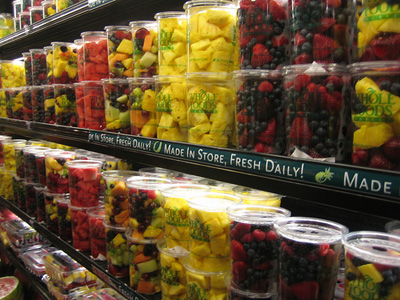So many things change when you start eating healthier. When I dieted after my third pregnancy I learned that if I did not want to eat something, I better not have it in the house. If I had to drive a few miles to go get something I should not be eating, then I was less likely to eat it.
This is my refrigerator at the moment. The Walmart grocery bag has chicken legs I bought at a marked down price *fist pump*. The purple lidded container is full of peeled carrots (my eight year old's daily task- we eat a lot of carrots). The yellow carton of eggs is from our chickens; the other carton is organic from the store. On the bottom shelf, in the back, are two half gallon jars of chicken bone broth. In the refrigerator drawers we have cabbage and carrots (winter staples). In the door I have wine, yogurt, butter, organic steak sauce (my husband brought this home, it is unopened), organic ketchup (my husbands), fish oil (orange flavor), organic mustard, filtered water, cold coffee, and beer.
This does not phase me. I did not even realize my refrigerator contents had changed all that much, until my mother came to live with me for six months. She was really surprised at the lack of food in my refrigerator. So surprised, in fact, that she web cam-ed her sister, and made a point to show her my refrigerator.
When you eat unprocessed foods, you can not have too much on hand at once, or you risk some things spoiling. My refrigerator looked a lot like this one, before I started GAPS.
I believe the refrigerator I grew up with looked similar to this, as well. When I went looking for pictures of refrigerators I was shocked. I had forgotten how mine use to look. Now, I want to stop a second to let you all know that I do not go into peoples houses and judge them by the contents of their refrigerator. And I would also like to add that it is not what you eat every once in a while, but what you eat all the time that matters. Processed foods have long shelf lives, compared to unprocessed foods.
In the summer my refrigerator looks a lot like this one.
I have all kinds of things from my garden I pack in there. I have to be careful I do not forget about things, or they will go bad. I use my freezer a lot for storing vegetables for the winter. I do can, a bit. Canning is technically processing food. When you can at home you avoid preservatives generally found in canned foods. I do buy organic canned tomato products. A fresh from the garden tomato is a better choice, but not always an option, especially up here in the North.
What kinds of foods we eat is a choice we all make for ourselves and maybe our families. There is so much information out there telling us what is good, and what is "bad". I get really overwhelmed by this. I have found a rule of thumb that helps me navigate the information available out there. How natural is it?
God created this world, and I have found that the more simple, natural, whole the food is, the better my family feels. Again, it is not what you eat once in awhile, but what you eat all the time that is going to affect you.
Another important thing I want to mention is switching from a traditional American diet, to a unprocessed/whole food diet. You may not do well. Back when I was dieting after my third kid, I started to switch all our grains to whole grains. I was on a roll, pasta, bread, cereal, you name it, if they made it whole grain, I switched over. Unfortunately, this did not have the desired affect. Our guts were just not able to hand the whole grains after years of not ever eating them. This is when I first realized that my son (at the time one year old) and my husband had a gluten allergy. The whole grain was very hard to digest for them.
Instead of switching from a traditional American diet right into a more whole food diet, I would suggest Paleo, at least for a little bit. Paleo is a no grain, whole food diet. Many people who have health issues have found relief from the diet. Or, I would suggest taking it slow, switching a few foods at a time. Most of all I would highly recommend GAPS, especially if you have digestive problems of any form.
Whatever you end up eating, remember that you are what you eat.


.JPG)



.JPG)




